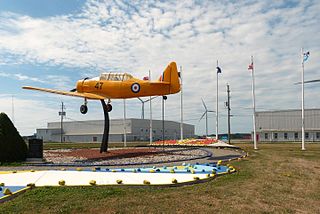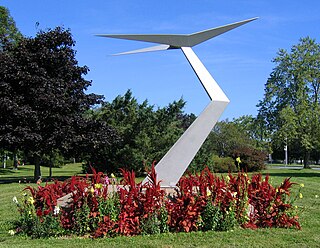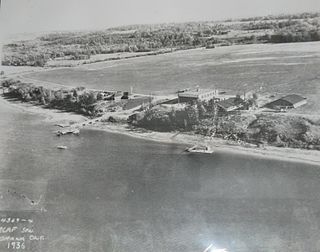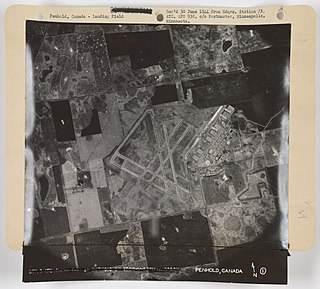
Leaside (/'liːˌsaɪd/) is an affluent neighbourhood in Toronto, Ontario, Canada. It is located northeast of Downtown Toronto, in the vicinity of Eglinton Avenue East and Bayview Avenue. The area takes its name from William Lea and the Lea family, who settled there in the early years of the 19th century. The area first developed as farmland along with Toronto through the 19th century. It was incorporated as a town in 1913. In 1967, it amalgamated with the township of East York to form the borough of East York. In 1998, it became part of the city of Toronto. It is commonly seen as one of the most expensive and exclusive neighbourhoods in the city with a median household income of $129,930, serving upper-middle-class families.
Canadian Forces Base Summerside was an air force base located in St. Eleanors, Prince Edward Island, Canada, now part of the city of Summerside.

Canadian Forces Base Goose Bay, commonly referred to as CFB Goose Bay, is a Canadian Forces Base located in the municipality of Happy Valley-Goose Bay in the province of Newfoundland and Labrador. It is operated as an air force base by the Royal Canadian Air Force (RCAF). Its primary RCAF lodger unit is 5 Wing, commonly referred to as 5 Wing Goose Bay.

Pendleton Airport is located 3 nautical miles northwest of Pendleton, Ontario, Canada, east of Ottawa. The airfield is currently operated by the Gatineau Gliding Club.

St. John's International Airport is in Newfoundland and Labrador, Canada. It is located 3 nautical miles northwest of St. John's, Newfoundland and Labrador and serves the St. John's metropolitan area and the Avalon Peninsula. The airport is part of the National Airports System, and is operated by St. John's International Airport Authority Inc.

Cartierville Airport(IATA: YCV, ICAO: CYCV) was an airport in Saint-Laurent, Quebec, now a borough of Montreal. The airport was decommissioned in 1988 and turned into the Bois-Franc neighbourhood. It was located next to Route 117 and the terminal buildings were accessed via Boul. Henri-Bourassa, near the present Bois-Franc Train Station on the Deux Montagnes Commuter Rail Line.
Long Branch Aerodrome was an airfield located west of Toronto, Ontario and just east of Port Credit, now Mississauga, and was Canada's first aerodrome. The airport was opened by the Curtiss Flying School, part of the Curtiss Aeroplane and Motor Company, as a pilot training school in 1915. In 1917 the airport was run by the Royal Flying Corps (RFC), and then closed in 1919. It is recognized by the existence of Aviation Road in the Lakeview, Mississauga community and a historical plaque.

RCAF Station Vulcan, also referred to as RCAF Aerodrome Vulcan, was a Second World War flying training station located southwest of the town of Vulcan, Alberta, Canada. It was one of many stations that were established in Canada under the British Commonwealth Air Training Plan.
RCAF Station Fort Macleod was a World War II British Commonwealth Air Training Plan (BCATP) flying training station. Administrative and operational control was the responsibility of the Royal Canadian Air Force (RCAF). The old station is located south of Fort Macleod, Alberta, Canada.

Dunnville Airport(TC LID: CDU9) was a registered aerodrome located 2 nautical miles south of Dunnville, Ontario, Canada. It was built during World War II as part of the British Commonwealth Air Training Plan and was home to Royal Canadian Air Force No.6 Service Flying Training School, which opened on 25 November 1940 and closed on 1 December 1944. There is a museum at the airport commemorating the training school.

Saunders Park is an urban park in Halifax, Nova Scotia, Canada. It is located in West End, Halifax on Chebucto Road at the site of the now defunct Halifax Civic Airport, the city's first aerodrome built on the former Bluebell Farm in 1931. The airfield had two grass airstrips, initially at 1800 x 600 feet and 2000 x 600 feet and extended by 200 and 250 respectively in 1938. It operated until 1941 when the land was converted to an army base and civil airport operations were moved to Dartmouth Airport and then to Halifax International Airport in 1960. The hangars and terminal building were located near the present day park along Connaught Avenue. The park serves the neighbourhood of Westmount.

Several air force stations and other establishments, many of them training facilities, operated in Calgary, Alberta, Canada from the mid-1930s to the mid-1960s.

Canadian Forces Base St. Hubert was a Canadian Forces Base in the city of Saint-Hubert, Quebec. The base began as a civilian airfield in the 1920s and was later also used by RCAF auxiliary (reserve) squadrons, beginning in the mid-1930s. It became a fully-fledged RCAF station early in World War II, being extensively used for training as part of the British Commonwealth Air Training Plan. After the war, it grew into one of the most important air bases in Canada, and remained so for decades.

Canadian Forces Base Rockcliffe is a former Canadian Forces Base located in the eastern part of Ottawa, Ontario, now used for Ottawa/Rockcliffe Airport and the Canada Aviation and Space Museum.

Redhill Aerodrome is an operational general aviation aerodrome located 1.5 NM south-east of Redhill, Surrey, England, in green belt land.
A list of Airfields of the Royal Flying Corps.
De Lesseps Field was a small, but important airfield in early aviation in Toronto, Ontario, Canada.

Royal Canadian Air Force Station Dunnville was a Second World War British Commonwealth Air Training Plan (BCATP) station located near Dunnville, Ontario. The station was home to No. 6 Service Flying Training School and is usually known by that name. Service Flying Training schools trained pilots, either single engine or multi-engine, and 6 SFTS was a single engine school. After graduation the new pilots were assigned various duties, which might be overseas in the Royal Air Force or an RCAF squadron; or in Canada as instructors or staff pilots in the BCATP, or for duty in RCAF Home Defence squadrons.

RCAF Station Penhold was a Second World War British Commonwealth Air Training Plan (BCATP) station located near Penhold, Alberta, Canada.















